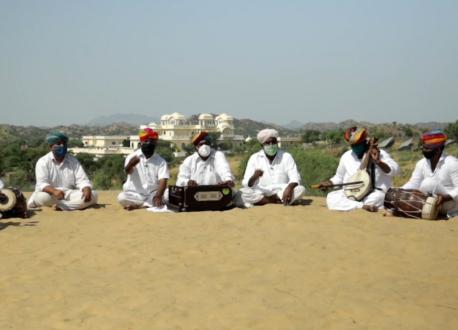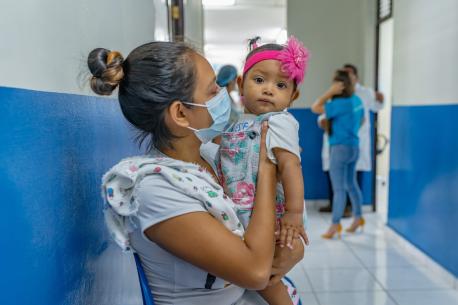
Schools Should Be the Last to Close and the First to Reopen
Even as the Omicron variant takes hold, keeping schools safe and open must be a global priority. The harms to children from being out of school are severe and can last a lifetime.
As COVID-19 cases spike again all over the world, fueled by the highly transmissible Omicron variant, parents, teachers and students are grappling with school closures.
"One thing we do know for certain: Another wave of widespread school closures would be disastrous for children," UNICEF Executive Director Henrietta Fore warned on December 17.
"The evidence is clear: prolonged, nationwide school closures, limited resources for students, teachers and parents and lack of access to remote learning have wiped out decades of progress in education and rendered childhood unrecognizable. A shadow pandemic of child labor, child marriage and mental health issues has taken hold."

A group portrait of students wearing masks at Gandaria Mohila Shomity Government Primary School, Dhaka, Bangladesh on September 12, 2021. © UNICEF/UN0527661/Sujan
Prolonged, nationwide school closures have already wiped out decades of progress in education
Schools in Uganda reopened this month after being closed for nearly two years in the world's longest pandemic-related shutdown. Some students were able to access remote education, but for more than half of the nation's students, learning stopped abruptly in March 2020. Many went to work to support their families; authorities warned that one-third of Uganda's students may never return to class.
Of those students who have been able to access remote learning during school closures around the world, many have struggled due to a lack of support. At least one-third of the world's schoolchildren have had no access to remote learning at all.

At Katabi Primary School in Entebbe, Uganda, pupils must wash their hands before entering the school premises. Schools in Uganda reopened in January 2022 after being fully or partially closed for more than 83 weeks — the world's longest pandemic-related disruption of education. © UNICEF Uganda/2022/Wamala
Online education does not produce the same outcomes as in-person school
Even for those with access to online education, outcomes were not the same as in-person school. A McKinsey report examining the effects of COVID-19 on the 2020-21 school year in the U.S. found that the pandemic left students on average five months behind in math and four months behind in reading. In math, students in majority Black schools ended the academic year with six months of unfinished learning, students in low-income schools with seven.
One million U.S. students didn't show up in-person or online at all, according to data from the National Center for Education Statistics. Young children and students from families living below the federal poverty line were the most likely to miss out on school completely.

Boys and girls celebrate their return to school with coloring books and masks at Chiguatillo Fiscal School, Playa Grande Community, Esmeraldas, Ecuador in September 2021. © UNICEF/UN0518076/Pintado
In-person school provides students with safety, daily interactions with friends, access to health care and, too often, the only nutritious meal of the day
The risks of children being out of school remain greater than the risks of being in school. "Beyond lost learning, children have also lost the safety of school, daily in-person interactions with friends, access to health care and, too often, their only nutritious meal of the day," Fore said.
The current generation of schoolchildren could collectively lose $17 trillion in potential lifetime earnings, Fore noted. “That is why nationwide school closures should be avoided whenever possible. When COVID-19 community transmission increases and stringent public health measures become a necessity, schools must be the last places to close and the first to reopen."
UNICEF maintains that the right to go to school and learn is central to every child's development. Three reasons why keeping kids in school must be a global priority:
- School closures deepen an existing learning crisis; the longer schools are shut, the more students fall behind in their learning. Basic reading and math skills are already in sharp decline among the most vulnerable students.
- Education is a powerful tool to fight poverty. Children with less schooling are more likely to live in poverty for the rest of their lives — their own children too.
- School closures are affecting the mental health of an entire generation of children. It's unacceptable for bars, restaurants and gyms to be open while schools remain closed. Children need to be in school now.
2022 cannot be yet another year of disrupted learning. It needs to be the year that education, and the best interests of children, take precedence. — UNICEF Executive Director Henrietta Fore
“We know that mitigation measures in schools are effective," Fore said. "We must use this knowledge to do everything we can to keep schools open. We must also increase investments in digital technology to make sure no child is left behind. 2022 cannot be yet another year of disrupted learning. It needs to be the year that education, and the best interests of children, take precedence.”
UNICEF is working across 190 countries and territories to ensure children receive the education they need to each their full potential. You can help.
The bipartisan Keeping Girls in School Act is designed to harness the power of U.S. Government to address the barriers that prevent girls from getting an education. Urge your Members of Congress to support legislation that empowers girls around the world.
TOP PHOTO: Six-year-old Asal, whose family left Afghanistan when she was 4, eagerly began her first day of formal education with other children staying in a temporary reception center for migrants and refugees in Sarajevo, Bosnia and Herzegovina, in October 2021. "I am happy to go to school today. I like drawing the most. My mother taught me English, and now I will learn Bosnian," Asal said, hugging her new UNICEF backpack full of school supplies. © UNICEF/UN0535351/Djemidzi
HOW TO HELP
There are many ways to make a difference
War, famine, poverty, natural disasters — threats to the world's children keep coming. But UNICEF won't stop working to keep children healthy and safe.
UNICEF works in over 190 countries and territories — more places than any other children's organization. UNICEF has the world's largest humanitarian warehouse and, when disaster strikes, can get supplies almost anywhere within 72 hours. Constantly innovating, always advocating for a better world for children, UNICEF works to ensure that every child can grow up healthy, educated, protected and respected.
Would you like to help give all children the opportunity to reach their full potential? There are many ways to get involved.




